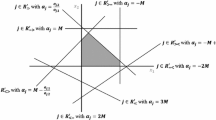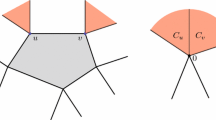Abstract
The paper deals with the average number of pivot steps required by the Simplex-Method for solving linear programming problems withm inequality-restrictions inn variables.
Them hyperplanes bounding the feasible regions of the corresponding inequalities are assumed to be distributed independently, identically and symmetrically under rotations in then-dimensional Euclidean space.
A certain variant of the Simplexalgorithm, the so-called Schatteneckenalgorithmus, is analyzed. This variant can even be used for the calculation of a start vertex.
For the expected number of pivot steps required for the solution of the programming problem an explicit upper bound, which is polynomial inm andn, can be derived.
This result implies that the average computation-time required for solving the problem is polynomial inm andn, too.
Zusammenfassung
Die vorliegende Arbeit befaßt sich mit der durchschnittlichen Zahl von, die benötigt werden, um lineare Optimierungsprobleme mitm Ungleichungs-Nebenbedingungen inn Variablen mit dem Simplexverfahren zu lösen.
Diem Hyperebenen, die die Zulässigkeitsbereiche der zugehörigen Ungleichungen begrenzen, seien unabhängig, identisch und rotationssymmetrisch imn-dimensionalen euklidischen Raum verteilt.
Eine bestimmte Variante des Simplexalgorithmus, der sogenannte Schatteneckenalgorithmus, wird untersucht. Diese Variante kann sogar benutzt werden, um eine Startecke zu bestimmen.
Für die erwartete Anzahl der Pivotschritte, die zur Lösung des Optimierungsproblems erforderlich sind, kann eine explizite obere Schranke, die polynomial ist inm undn, hergeleitet werden.
Dieses Resultat garantiert, daß die durchschnittliche Rechenzeit zur Lösung des Problems ebenfalls polynomial ist inm undn.
Similar content being viewed by others
References
Avis, D., andV. Chvatal: Notes on Bland's Pivoting Rule. Mathematical Programming Study8, 1978, 24–34.
Borgwardt, K.H.: Untersuchungen zur Asymptotik der mittleren Schrittzahl von Simplexverfahren in der Linearen Optimierung. Dissertation, Universität Kaiserslautern, 1977a.
—: Untersuchungen zur Asymptotik der mittleren Schrittzahl von Simplexverfahren in der Linearen Optimierung. Operations Research Verfahren28, 1977b, 332–345.
—: Zum Rechenaufwand von Simplexverfahren. Operations Research Verfahren31, 1978, 83–97.
—: Die asymptotische Ordnung der mittleren Schrittzahl von Simplexverfahren. Methods of Operations Research37, 1979, 81–95.
-: Some Distribution-Independent Results about the Asymptotic Order of the Average Number of Pivot-Steps of the Simplex-Method. To appear in Mathematics of Operations Research.
Dantzig, G.B.: Expected Number of Steps of the Simplex Method for a Linear Program with a Convexity Constraint. Dept. of Operations Research, Stanford University, Technical Report SOL 80-3R, 1980, revised Oct. 1980.
Efron, B.: The Convex Hull of a Random Set of Points. Biometrica52 (3) and (4), 1965, 331–345.
Gács, P., andL. Lovász: Khachiyan's Algorithm for Linear Programming. Dept. of Computer Science, Stanford University, Technical Report STAN-CS-79-750, 1979.
Goldfarb, D., andW.J. Sit: Worst Case Behaviour of the Steepest Edge Simplex Method. Discrete Applied Mathematics1, 1979, 277–285.
Hirche, J.: Basishäufigkeit bei linearen Restriktionen. Math. Operationsforschung Statist., Ser. Optimization10 (1), 1979, 27–37.
Jeroslow, R.G.: The Simplex Algorithm with the Pivot-Rule of Maximizing Criterion Improvement. Discrete Mathematics, 1973, 367–377.
Kelly, D.G.: Some Results on Random Linear Programs. Department of Statistics, Univ. of North Carolina, 1981.
Khachiyan, L.: A Polynomial Algorithm in Linear Programming. Doklady Akademika Nauk UdSSR224, 1979, 1093–1096; English translation in Soviet Math. Dokl.20, 191–194.
Klee, V., andG. Minty: How Good is the Simplex-Algorithm? Inequalities III. Ed. by O. Shisha. New York 1971.
Körner, F.: Über die optimale Größe von Teiltableaus beim Simplexverfahren. Technische Universität Dresden, 1980, Preprint.
Liebling, T.: On the Number of Iterations of the Simplex Method. OR-Verfahren17, 1973, 248–264.
Orden, A.: A Study of Pivot Probabilities in LP-Tableaus. Report 7653, University of Chicago, Dept. of Economics, 1976.
Raynaud, H.: Sur l'Enveloppe Convexe des Nuages de Points Aléatoires dans Rn. Journal of Applied Probab.7, 1970, 35–48.
Schmidt, B.K., andT.H. Mattheis: The Probability that a Random Polytope is bounded. Mathematics of Operations Research2 (3), 1977, 292–296.
Schmidt, W.M.: Some Results in Probabilistic Geometry. Zeitschrift für Wahrscheinlichkeitstheorie und verwandte Gebiete9, 1968, 146–157.
Telgen, J.: Redundancy and Linear Programs. Dissertation, Erasmus Universität Rotterdam, 1979.
Telgen, J., andA.H.G. Rinnooy Kan: The complexity of linear programming. Statistica Neerlandica2, 1981.
Zadeh, N.: What is the worst case behaviour of the simplex method? Technical Report No. 27, Department of Operations Research, Stanford University.
Author information
Authors and Affiliations
Rights and permissions
About this article
Cite this article
Borgwardt, K.H. The Average number of pivot steps required by the Simplex-Method is polynomial. Zeitschrift für Operations Research 26, 157–177 (1982). https://doi.org/10.1007/BF01917108
Received:
Revised:
Issue Date:
DOI: https://doi.org/10.1007/BF01917108




